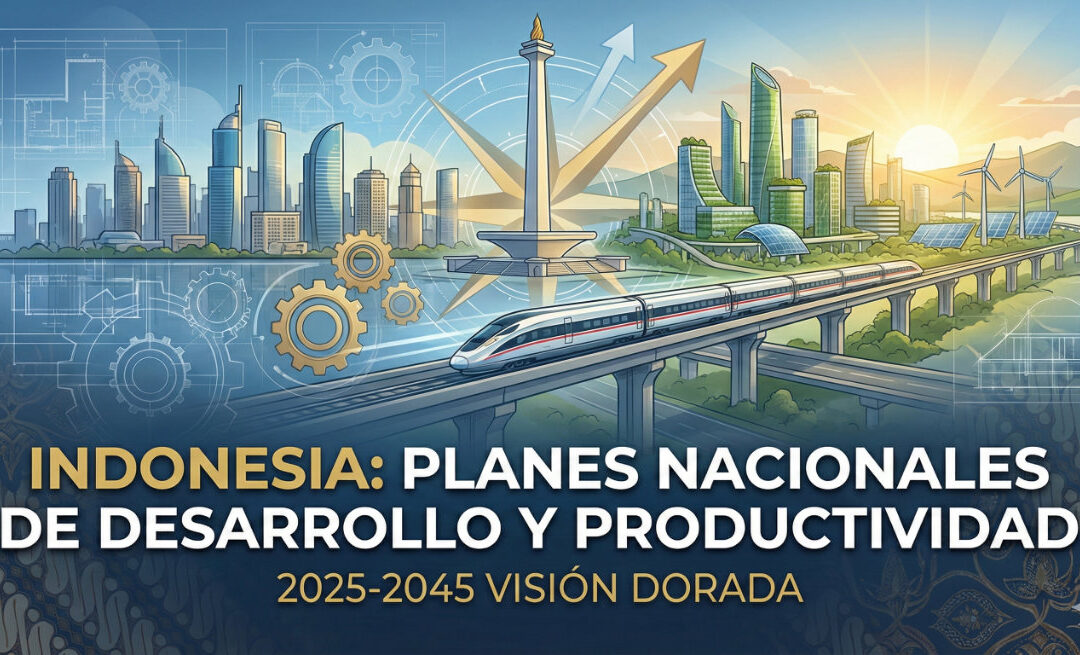
1. National Long-Term Development Plan 2025-2045
A few years ago, during his first term as president, Joko Widodo (Jokowi) launched the idea of implementing what he called “Golden Vision Indonesia 2045” (“Visi Indonesia Emas 2045”), with the aim of making Indonesia a sovereign, advanced, fair, and prosperous country by 2045, coinciding with the centenary of its independence. To this end, a long process of consultation began which culminated, under the presidency of Jokowi’s successor, Prabowo Subianto, with the adoption of the National Long-Term Development Plan 2025-2045, based on four pillars, in accordance with the five fundamental principles of the Indonesian State formulated by Sukarno in 1945 (“Pancasila”) and the Constitution: boosting human resources and fostering entrepreneurship, promoting sustainable development, fostering equitable growth and improving connectivity, and finally, strengthening national resilience and governance.
Alongside these pillars, the Plan contemplates various strategies, all of them decisive for Indonesia to become one of the world’s largest economies in 2045, especially those related to: a) education, capacity protection, and entrepreneurship; b) structural reforms, in particular the simplification of laws and regulations, the perfection of legal certainty, and the elimination of corruption; c) economic diversification, moving from a model based on raw materials to one driven by the manufacturing industry, digital technology, and services; and d) the consolidation of Indonesia’s presence in international forums – crucial in such a delicate geopolitical situation as the current one – to contribute to favoring the balance and stability of the international community.
2. National Medium-Term Development Plan 2025-2029
The National Long-Term Development Plan anticipates, given its extensive temporal scope of application, its execution in phases lasting five years each, the first being contained in the National Medium-Term Development Plan 2025-2029, adopted by Presidential Decree 12/2025, of February 10. It describes eight missions (“Eight Asta Cita”), key to carrying out the intended economic and social transformation, of which, due to their importance and significance for interested Spanish companies, I will highlight three: the continuous development of infrastructure; the progressive expansion of industries based on natural resources; and the strengthening – so necessary, so urgent – of the political, legal, and administrative reforms underway, as well as the prevention and eradication of corruption, an evil to which Indonesia, like other countries in the area, is unfortunately not alien.
The execution of these missions should allow, in the period contemplated, the achievement of, among others, the following results: increasing per capita income to equal that of developed countries (with an increase in the economic growth rate from 5.30% in 2025 to 8% in 2029 and per capita Gross National Income (GNI) from USD 5,410 in 2025 to USD 8,000 in 2029); improving Indonesia’s leadership in the world (with a climb from rank 33 in the Global Power Index (GPI) in 2025 to rank 29 in 2029); perfecting human resource competitiveness (moving from 0.56 in the Human Capital Index (HCI) in 2025 to 0.59 in 2029); and reducing greenhouse gas emissions to reach net zero emissions (with an evolution from 76.49% in the Environmental Quality Index (EQI) in 2025 to 77.20% in 2029).
3. National Productivity Master Plan 2025-2029
Aware of the challenges facing the country, derived, on the one hand, from an uncertain global context (geoeconomic fragmentation, climate volatility, changes in international trade rules), and, on the other, from declining productivity (of up to 2.60% in the past decade), the Ministry of National Development Planning (BAPPENAS) launched, in collaboration with the Asian Productivity Organization (APO), the National Productivity Master Plan 2025-2029. A launch based on an axiom as clear and evident as the fact that without productivity, which is at the heart of any development plan and is an essential factor thereof, it is difficult to materialize the motto “Smart People, Smart Economy, Smart Nation”, intended to convey to all a message aimed at summarizing the purpose of the Plan and generating confidence in it.
This Plan, a complement to the National Medium-Term Development Plan 2025-2029, is structured around various strategic levers starting from a crucial element, the importance of total factor productivity (TFP) in growth – as Robert Solow had already anticipated, by the way, in 1957 – and its three variables (labor force, resource allocation, and trade openness). Among these strategic levers, in my opinion, three stand out above all: regulatory coherence; infrastructure and digital transformation, including smart logistics and regional technological parks; and education and research and development. The first, regulatory coherence, and its corollary, administrative simplification, will undoubtedly contribute to streamlining procedures, eliminating redundant obligations, and promoting digitalization, despite the recent launch of the INA Digital platform, indispensable, but not sufficient.
4. Concretization of pillars, strategies, missions, and levers
As I explained a few lines back, the National Long-Term Development Plan starts from a theoretical scheme, reasonably structured, which is divided into various pillars and strategies; the National Short-Term Development Plan does the same, in turn, with different missions; and the National Productivity Master Plan, finally, attempts something similar, with different levers. Now, the most complex part, and the one to which most attention must be paid, is the concretization of all these Plans, and above all, as I say, their respective pillars, strategies, missions, and levers, at the different national, regional, or provincial levels (regencies -“Kabupaten”- and cities -“Kota”-), in order to gauge the scope and content of the change in productive model intended to be carried out, the business opportunities it may yield, and, in this context, the fit of the interests of Spanish companies within it.
5. Infrastructure and Public-Private Partnership (PPP)
If we dwell on the missions of the National Short-Term Development Plan and the levers of the National Productivity Master Plan, we observe that they place special emphasis on the infrastructure sector, essential for economic growth and instrumental for territorial connectivity. Boosting them will require, according to the forecasts of the National Medium-Term Development Plan, minimum investments of around 1,905 trillion rupiahs (about 100 million euros) in the 2025-2029 period, of which 35.63% will be borne by state funds, 24.78% by regional funds, and the rest by private funds, national or foreign, decisive for the success of this boost. Consistent with this, the International Conference on Infrastructure, held in Jakarta on June 11 and 12, debated priority projects and public-private partnership (PPP).
Among the priority projects highlighted were those of the new Indonesian capital, Nusantara, in East Kalimantan (Borneo), still half-built; the Jakarta-Surabaya high-speed railway line; the giant sea wall (“Giant Sea Wall”), intended to protect coastal areas, especially that of Jakarta, from flooding and sea-level rise, which will extend for 700 kilometers and span from Banten to East Java; the construction, expansion, and modernization of ports, to consolidate their role as economic and logistics engines; sustainable water resource management; comprehensive waste treatment; the development of renewable energies; or the planning, design, and maintenance of roads and highways, projects, finally, that offer multiple possibilities to Spanish companies, despite fierce competition from companies in other countries in the area.
Regarding public-private partnership (PPP), the current scheme, as recognized by the Minister of Public Works and Housing, Dody Hanggodo, is a complex and bureaucratic scheme that hinders investment attraction, hence the need for legislative reform to replace current regulations. Presidential Decree 38/2015, of March 20, which had amended Decree 13/2010, of January 28, at the time, requires a prompt revision that urgently addresses issues such as the uncertainty and inconsistency of legal overlaps, problems with project preparation and feasibility, or the lack of transparency in their selection. A revision is all the more necessary as this scheme, as stated by the Coordinating Minister for Infrastructure and Development, Agus Harimurti Yudhoyono, is key to effective and efficient collaboration between the public sector and the private sector.

